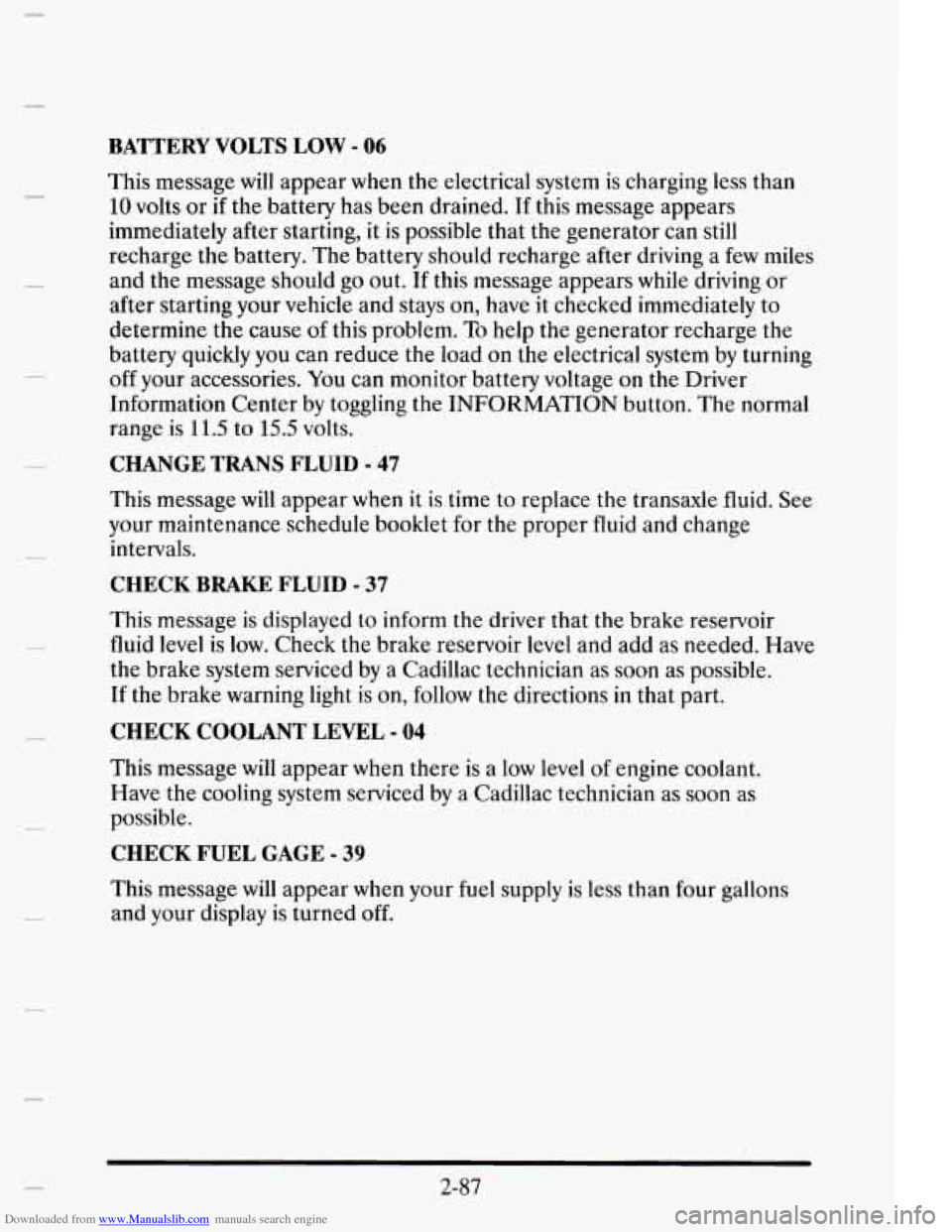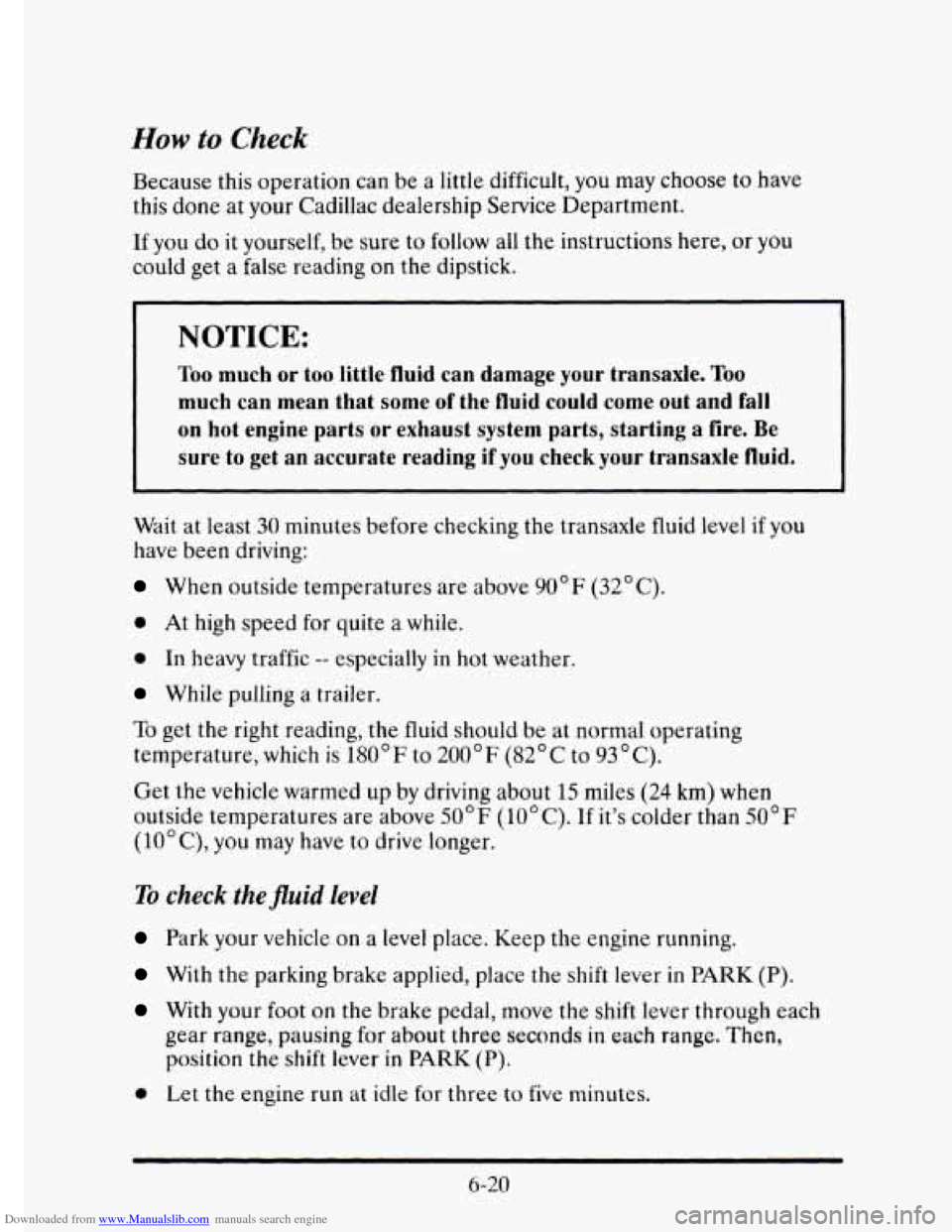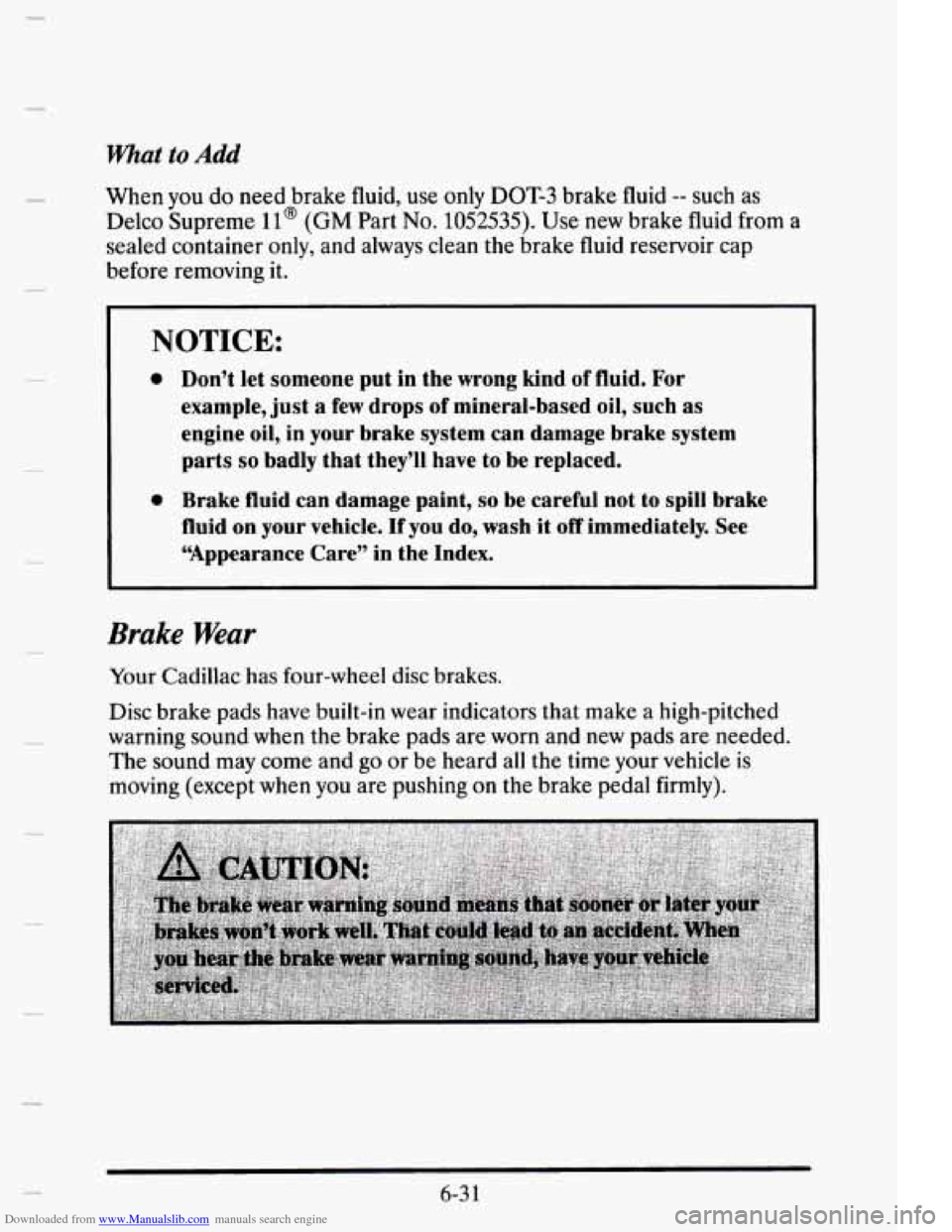Page 158 of 395

Downloaded from www.Manualslib.com manuals search engine BATTERY VOLTS LOW - 06
This message will appear when the electrical system is charging less than
10 volts or if the battery has been drained. If this message appears
immediately after starting,
it is possible that the generator can still
recharge the battery. The battery should recharge after driving a few miles
and the message should go out. If this message appears while driving or
after starting your vehicle and stays on, have
it checked immediately to
determine the cause
of this problem. To help the generator recharge the
battery quickly you can reduce the load on the electrical system by turning
off your accessories. You can monitor battery voltage on
the Driver
Information Center by toggling the
INFORMATION button. The normal
range
is 11.5 to 15.5 volts.
CHANGE TRANS FLUID - 47
This message will appear when it is time to replace the transaxle fluid. See
your maintenance schedule booklet for the proper fluid and change
intervals.
CHECK BRAKE FLUID - 37
This message is displayed to inform the driver that the brake reservoir
fluid level is low. Check
the brake reservoir level and add as needed. Have
the brake system serviced by a Cadillac technician as soon as possible.
If the brake warning light is on, follow the directions in that part.
CHECK COOLANT LEVEL - 04
This message will appear when there is a low level of engine coolant.
Have the cooling system serviced by a Cadillac technician as soon as
possible.
CHECK FUEL GAGE - 39
This message will appear when your fuel supply is less than four gallons
and your display is turned off.
2-87
Page 211 of 395
Downloaded from www.Manualslib.com manuals search engine HILL AND MOUNTMN ROADS
Driving on steep hills or mountains is different from driving in flat or
rolling terrain.
If you drive regularly in steep country, or if you’re planning to visit there,
here are some tips that can make your trips safer and more enjoyable.
0 Keep your vehicle in good shape. Check all fluid levels and also the
brakes, tires, cooling system and transaxle. These parts can work hard
on mountain roads.
Know how to go down hills. The most important thing to know is this:
let your engine do some
of the slowing down. Shift to a lower gear
when you
go down a steep or long hill.
4-24
Page 226 of 395

Downloaded from www.Manualslib.com manuals search engine Parking on Hills
c
You really should not park your vehicle, with a trailer attached, on a hill.
If something goes wrong, your rig could start to move. People can be
injured, and both your vehicle and the trailer can be damaged.
But
if you ever have to park your rig on a hill, here’s how to do it:
1. Apply your regular brakes, but do not shift into PARK (P).
2. Have someone place chocks under the trailer wheels.
3. When the wheel chocks are in place, release the regular brakes until
the chocks absorb the load.
4. Reapply the regular brakes. Then shift into PARK (P) firmly and apply
5. Release the regular brakes.
your parking
brake.
When You Are Ready to Leave Afier Parking on a Hill
1. Apply your regular brakes and hold the pedal down while you:
Start your engine;
Shift into a gear; and
Be sure the parking brake has released.
2. Let up on the brake pedal.
3. Drive slowly until the trailer is clear of the chocks.
4. Stop and have someone pick up and store the chocks.
Maintenance When Trailer Towing
Your vehicle will need service more often when you’re pulling a trailer.
See the Maintenance Schedule
for more on this. Things that are especially
important in trailer operation are automatic transaxle fluid (don’t
overfill), engine oil, belt, cooling system, and brake adjustment. Each
of
these is covered in this manual, and the Index will help you find them
quickly.
If you’re trailering, it’s a good idea to review these sections before
you start your trip.
Check periodically to see that all hitch nuts and bolts are tight.
4-39
Page 268 of 395
Downloaded from www.Manualslib.com manuals search engine Fluid Usage Label
LI
Then go to the front of
the vehicle and lift the
secondary hood release
to open the hood.
The fluid usage label is a color coded label identifying the various fluids
used in your vehicle.
Colors represented on the label match the lettering or handle color
of the
fluid you want
to check.
0 GREEN: Engine Coolant
ORANGE: Power Steering Fluid
0 YELLOW: Engine Oil
0 RED: Transmission Fluid
0 WHITE: Brake Fluid
BLUE: Washer Fluid
6-9
Page 279 of 395

Downloaded from www.Manualslib.com manuals search engine How to Check
Because this operation can be a little difficult, you may choose to have
this done at your Cadillac dealership Service Department.
If you do it yourself, be sure to follow all the instructions here, or you
could get a false reading on the dipstick.
NOTICE:
Too much or too little fluid can damage your transaxle. Too
much can mean that some of the fluid could come out and fall
on hot engine parts or exhaust system parts, starting a fire. Be
sure to get an accurate reading if you check your transaxle fluid.
Wait at least 30 minutes before checking the transaxle fluid level if you
have been driving:
When outside temperatures are above 90°F (32'C).
0 At high speed for quite a while.
0 In heavy traffic -- especially in hot weather.
While pulling a trailer.
To get the right reading, the fluid should be at normal operating
temperature, which is
180°F to 200°F (82OC to 93°C).
Get the vehicle warmed up by driving about 15 miles (24 km) when
outside temperatures are above
50°F ( 10°C). If it's colder than 50°F
(lO"C), you may have to drive longer.
To check the fluid level
Park your vehicle on a level place. Keep the engine running.
With the parking brake applied, place the shift lever in PARK (P).
With your foot on the brake pedal, move the shift lever through each
gear range,
pausing €or about three seconds in each range. Then,
position the shift lever in PARK (P).
0 Let the engine run at idle for three to five minutes.
6-20
Page 288 of 395
Downloaded from www.Manualslib.com manuals search engine Your brake master cylinder is here. It is filled with DOT-3 brake fluid.
. , .~ . ~I~. . . . . .. ~~
P
P
r
g.
t
.: i
r !
r
k
6-29
Page 289 of 395
Downloaded from www.Manualslib.com manuals search engine To Check Brake Fluid
Remove the cap.
. .. .. . , ... r .._ ..:- . , -.
The fluid level must be to the maximum fill line at the base of the neck as
shown.
When your brake fluid>$alis
to a low level, your brake warning light will
come
on. See "Brake System Warning Light" in the Index.
,
6-30
Page 290 of 395

Downloaded from www.Manualslib.com manuals search engine Khat to Add
c
When you do need brake fluid, use only DOT-3 brake fluid -- such as
Delco Supreme
ll@ (GM Part No. 1052535). Use new brake fluid from a
sealed container only, and always clean the brake fluid reservoir cap
before removing it.
NOTICE:
e Don’t let someone put in the wrong kind of fluid. For
example, just a few drops of mineral-based oil, such
as
engine oil, in your brake system can damage brake system
parts
so badly that they’ll have to be replaced.
0 Brake fluid can damage paint, so be careful not to spill brake
fluid
on your vehicle. If you do, wash it off immediately. See
‘!Appearance Care” in the Index.
Brake Wear
Your Cadillac has four-wheel disc brakes.
Disc brake pads have built-in wear indicators that make a high-pitched
warning sound when the brake pads are worn and new pads are needed.
The sound may come and
go or be heard all the time your vehicle is
moving (except when you are pushing on the brake pedal firmly).
6-3 1